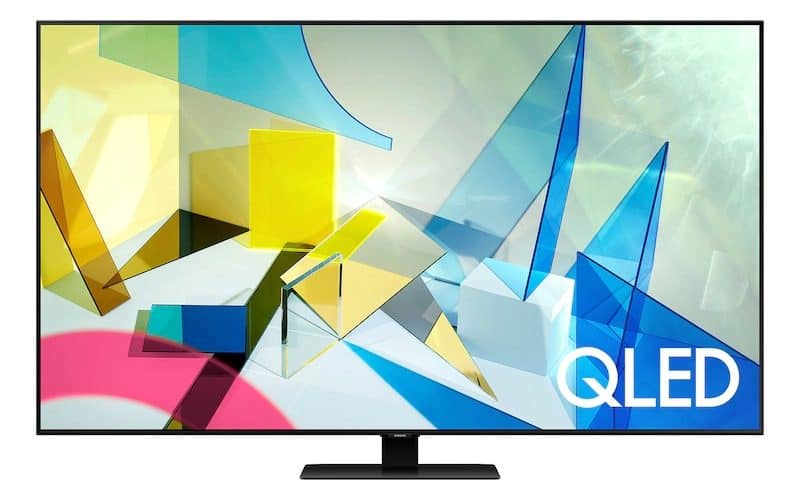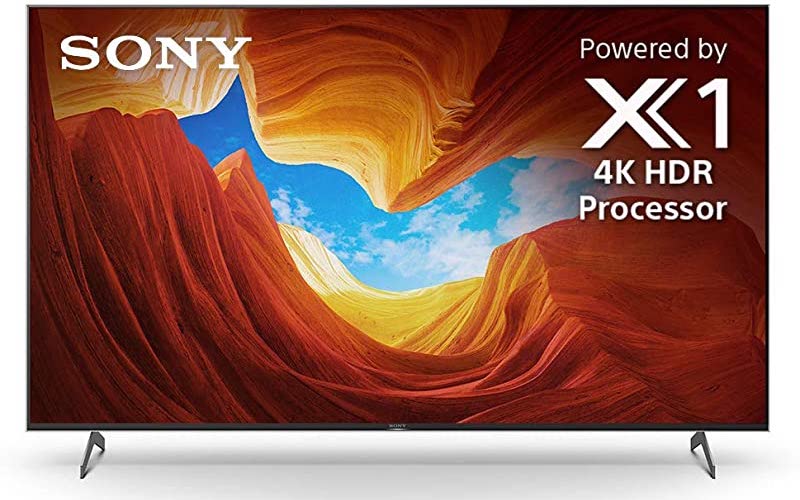Samsung or Sony? Deciding between these two top TV brands is never an easy choice, especially considering the many diverse models they put out every year. On this Sony X900H vs Samsung Q80T post, we look at two of their top-quality medium-range TV sets that have taken over the market recently. Read on to find out which one is right for you.
Samsung Q80T vs Sony X900H – Quick Comparison
Samsung Q80T

The Q80T might be Samsung’s second-tier 4K TV set, but it still comes with some remarkable and superior features. The most significant pros and cons of this superb all-around TV are:
Pros:
- Powerful UHD Quantum Image processor
- Supports VRR, G-Sync, and FreeSync
- Impressive motion handling technology
- Great Tizen OS and Bixby smart voice assistant
Cons:
- No Dolby Vision
- More expensive than other TVs with the same features
Sony X900H

Stunning picture quality, beefy processing power, and Dolby Vision support make this Sony model a tough opponent for many other brands out there and a hard option to ignore if you’re looking for an imposing all-rounder. Here are some of X900H’s biggest pros and cons:
Pros:
- Powerful X1 processor
- Excellent contrast ratio
- Fast and intuitive Smart TV OS with tons of apps
- Supports Dolby Vision and Dolby Atmos
Cons:
- Poor viewing angles
- No HDR10+
Features Face to Face
Panel Technology
The two TVs both feature LED VA panels, with one notable difference. The X900H uses a standard LED VA panel, while the Q80T comes with Samsung’s branded QLED panel technology. QLED panels are LED panels with a quantum-dot feature. In simple terms, this allows them to produce deeper blacks and deliver wider viewing angles than most VA panels.
When it comes to specific panel sizes, the Q80T offers you a bit more options, as you can pick from six different size variants ranging from 49’’ to 85’’. In comparison, the X900H only comes in four variants, from 55’’ to 85’’.
Image Processor
Samsung and Sony have made sure to put some of their strongest image processors in these two models. The Q80T comes with the UHD Quantum Image processor, while the X900H uses the X1 processor, Sony’s most powerful Smart TV processor to date. Both processors have excellent upscaling and picture-enhancing properties and many other advanced features.
Motion Technology
Although both models offer excellent motion technology, the Q80T outdoes the X900H in this category due to having impressive response times. It has a response time of 10.1 milliseconds, while the X900H has a response time of 11.2 milliseconds.
Though neither TV is flicker-free, they use Pulse-Width Modulation and work at a high flicker frequency so that most viewers won’t notice any flickering. That said, both TVs may display overshoot in some transitions, so you might occasionally notice motion artifacts when watching dark scenes.
Picture Quality
Picture quality is undoubtedly one of the essential attributes that differentiate TV sets. In this sense, the two TVs offer nearly identical picture quality capabilities, as they offer nearly indistinguishable supported resolution properties. We’ve created the streamlined table below to give you a better look at how the two TVs compare in this category:
| Resolution | Samsung Q80T | Sony X900H |
|---|---|---|
| 4K/120Hz | Yes (Native Support) | Yes (Native Support) |
| 4K/60Hz/4:4:4 | Yes | Yes |
| 4K/60Hz | Yes | Yes |
| 1440p/120Hz | Yes (Native Support) | No |
| 1440p/60Hz | Yes (Native Support) | Yes (Force Resolution) |
| 1080p/120Hz | Yes | Yes |
| 1080p/60Hz/4:4:4 | Yes | Yes |
Contrast Ratio / Black Level
Both TVs have an excellent contrast ratio, although the X900H puts up better numbers in this category. The Q80T comes with the “Ultra Viewing Angle” layer, which helps this model have better viewing angles than the X900H but at the expense of native contrast ratio. You can improve the contrast ratio on the Q80T and the X900H with local dimming, but not by much.
The difference in contrast ratios between these two models is not a deal-breaker. However, it is noticeable as blacks look deeper on the X900H, while on the Q80T, they can appear grayish from time to time.
Local Dimming
The Q80T and the X900H both come with full-array local dimming. The X900H’s local dimming settings perform a bit better, as there’s less blooming than with the Q80T. This Sony model is good at making highlights pop without being too distracting. On the other hand, the Q80T lacks a bit when it comes to this and can sometimes make the display corners flash when the entire screen is gray.
Peak Brightness
The two TVs offer good SDR and HDR brightness. They excel in dark and moderately lit environments and can deliver solid performances even in brighter rooms. To see how the two models compare in this category, check out the table below:
| Brightness Values | Samsung Q80T | Sony X900H |
|---|---|---|
| Peak 10% Window SDR Brightness | ∼ 710 nits | ∼ 460 nits |
| Peak 100% Window SDR Brightness | ∼ 420 nits | ∼ 460 nits |
| Peak 10% Window HDR Brightness | ∼ 740 nits | ∼ 450 nits |
| Peak 100% Window HDR Brightness | ∼ 440 nits | ∼ 540 nits |
As you can see from the table above, the Q80T outperforms the X900H in both SDR and HDR brightness. But, the most interesting data we can see from the table is just how well the Sony X900H performs across the 100% window. It offers much more stable numbers than the Q80T.
Color
The two TVs have an equally good color gamut, and both have the option to enable wide color gamuts. Additionally, they have excellent DCI P3 color space coverage, a crucial feature for HDR content. They also have solid coverage of the wider Rec. 2020 color space.
The Q80T shows its edge in color volumes, as it delivers slightly better results across all key color volume parameters. That said, the Q80T struggles to display dark colors because of its lower contrast ratio. Contrarily, the X900H has trouble displaying bright blues due to its higher contrast ratio.
Viewing Angle
The Samsung Q80T delivers better viewing angles than the X900H. However, this is not because the Q80T excels in this category but because the X900H has very narrow viewing angles. The X900H starts losing brightness at viewing angles of just over thirty degrees and shows black level raises at around fifteen degrees. The Q80T is a bit better, especially in the latter category, as it displays black level raises starting at around seventy degrees.
The Q80T comes with Samsung’s “Ultra Viewing Angle” layer, which does help improve viewing angles a bit at the expense of the overall contrast ratio. Conversely, the X900H doesn’t come with Sony’s “X-Wide Angle” layer, so it loses image accuracy very quickly as you move off-center.
Reflections / Anti-glare
The Q80T has notably better reflection handling properties than the X900H. This is primarily because the Q80T has a glossy screen finish, while the X900H only has a semi-gloss screen finish. In other words, the Q80T is much better at handling ambient light than the X900H.
To put this into specific numbers, the Q80T reflects just over one percent of light in all directions, while the X900H reflects four times as much. If you’re looking for a TV suitable for a well-lit room, the Q80T is a much better choice.
Sound Quality
The Q80T and the X900H offer equally decent sound properties. They have a solid frequency response and a well-balanced sound profile that can get reasonably loud. Both TVs also have fairly powerful bass, but not the room-shaking kind some buyers might be looking for.
Having said that, the distortion performance on the Sony X900H is a bit disappointing. It performs fairly well up to moderate audio levels but shows a lot of distortion when you’re pushing it close to its maximum volume.
Smart TV Platform (Operating System)
The two TVs employ different Smart TV platforms but deliver very similar performance results. The Samsung Q80T uses the company’s proprietary Smart TV Tizen operating system, while the Sony X900H runs on Android TV. Here’s a detailed Samsung Q80T vs Sony X900H OS comparison:
| OS Features | Samsung Q80T | Sony X900H |
|---|---|---|
| OS Version | Tizen OS (2020 Version) | Android TV (9.0 Version) |
| Time to Change Backlight | 6 seconds | 6 seconds |
| Time to Load YouTube | 2 seconds | 2 seconds |
| HDR Netflix/Youtube | Yes | Yes |
| App Selection/Variety | 9/10 | 9/10 |
| App Smoothness | 9/10 | 9/10 |
| Ease of Use | 9/10 | 7/10 |
Connectivity
Although these two models vary significantly in a few of the features we’ve discussed above, the connectivity section proves that they also share several identical traits. To see how much the Q80T and the X90H resemble each other in terms of connectivity, we’ll compare their wireless technologies, voice assistants, and input specifications.
Inputs
The two TVs deliver exceptional input lag numbers, albeit the Q80T is a slightly better performer across the board. With that in mind, it’s also crucial to consider the physical input specifications of both models, which we’ve outlined in the table below:
| Input Ports | Samsung Q80T | Sony X900H |
|---|---|---|
| HDMI Ports | 4 HDMI 2.1 Ports | 4 HDMI 2.1 Ports |
| USB Ports | 2 USB 2.0 Ports | 2 USB 2.0 Ports |
| Digital Optical Audio Out | 1 Port | 1 Port |
| Ethernet Port | Yes | Yes |
Voice Assistants
The two TVs use considerably different remotes. The Q80T has a small and minimalistic remote with less than a dozen buttons. In contrast, the X900H comes with a large remote with many shortcut buttons, including Netflix and the Google Play Store. Nevertheless, both TV remotes come with a built-in microphone you can use to activate a voice assistant.
In Q80T’s case, this is Samsung’s Bixby, a smart voice assistant that comes with all of Samsung’s smart appliances. For X900H, this is the Google Assistant. Both assistants allow you an extensive set of voice control options for more intuitive use.
Wireless Technologies
Even though the two TVs differ in many categories above, they are identical when it comes to this attribute, as they support the same wireless technologies. This includes the widely used Wi-Fi (2.4 GHz, 5 GHz) and Bluetooth (4.2 version) standards.
Standout Features
The main standout features of the Q80T are visible mainly through its gaming attributes. While the X900H supports both FreeSync and VRR, it lacks G-SYNC compatibility. This makes the Q80T a better choice for all gamers looking for a TV to pair with their NVIDIA graphics card.
By comparison, the X900H’s strongest standout feature is the presence of Dolby Vision. This feature allows for more vivid colors, sharper contrast, and richer details, enabling next-level HDR images.
Conclusion
To summarize this Sony X900H vs Samsung Q80T comparison post, we want to highlight that both TVs deliver excellent quality overall, so you can’t go wrong no matter which set you pick. That said, we should note a few pointers that can help you pick the model that best suits you.
With a higher contrast ratio, better local dimming feature, and Dolby Vision, the Sony X900H is a better choice for watching movies and shows in a dark environment. The Samsung Q80T has slightly lower input lag, a better response time, and a very wide VRR range, making it a more suitable option for users who also want to play video games on this TV.